Antique Roses
By Barbara Israel
A number of years ago (in the 1980s) one of my neighbors in Katonah introduced me to antique roses. Pretty soon I was pouring over catalogues reviving my French, loving the histories and learning the names and habits of all kinds of old garden roses. I soon found out that more often than not old roses were once-a-year bloomers but that they were fragrant when they did bloom. I also hadn’t realized that many of the old roses were disease resistant and wouldn’t need spraying.
I ended up ordering 22 in rootstock and am happy to say that some of them are still alive today. I love them all but some more than others, the Gallicas fascinate me, Blanc Double de Coubert, Sir Thomas Lipton, Constance Spry and Ispahan. The real excitement began quite a few years later when I ordered two enormous ramblers, Paul’s Himalayan Musk and Kiftsgate. I planted the Kiftsgate right next to a new young sugar maple and while it has not been a stellar bloomer it is still expending energy trying to reach the light through the thick leaves of the tree. But the two Paul’s Himalayan Musks are extraordinary surprises — one virtually covers the Pump House on the property and the other is a pink waterfall on the bare trunk of a conifer.

These are the catalogues that I used and ordered from all those years ago. Now, of course, they’re all online. Because there are so many places now that sell old roses the best way may be to look at the below general list of rose sellers and nurseries and do your own interviewing.
Roses of Yesterday and Today in Watsonville, CA www.rosesofyesterday.com
Pickering Nurseries in Port Hope, Ontario www.pickeringnurseries.com Good for winter hardy roses.
www.rose-roses.com The home page of this website is headed “Roses: And Everything About Them”. The link above is to the rose sellers and nurseries page which lists numerous sellers with comments and includes a section devoted to Old Rose Specialty Nurseries.
I hope you enjoy old roses as much as I do, I’m ready to try some new ones in 2010!
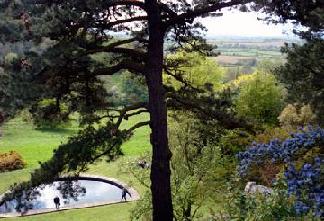
Kiftsgate Court Gardens
By Barbara Israel
The gardens at Kiftsgate, located in Gloucestershire, caught me by surprise. I went there specifically to see the legendary rambler rose said to be the largest rose bush in England but I also found a wonderful garden. Quite a few years ago I planted a Kiftsgate rose (Family: Rosaceae, Genus: Rosa, Species: Filipes, Cultivar: Kiftsgate) in my own garden. As I watched it clamber all over the new maple we planted at the same time I grew curious about its ancestry.
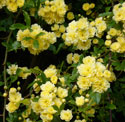
The house and grounds of Kiftsgate are perched on top of a steep hill just up the road from Lawrence Johnston’s Hidcote Manor. The view from the house is breathtaking and steps are set into the hillside so that you can walk down to the open lawn with its semi-circular black pool. Kiftsgate is a small enough garden that it is easy to enjoy and easy to navigate. I decided to just wander and look around as I searched for the famous rose. Instead I soon found a large yellow rambler Lady Banksia (R. banksiae lutea) rose scaling the facade of the Georgian house. As one of the early blooming roses it was in full form in early May when I visited the garden.
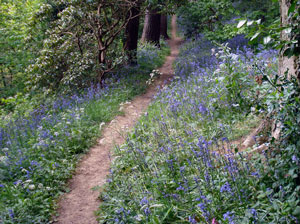
Then as I skirted around the edge of the hill watching keen garden visitors hike up from below I saw a sign for “Bluebell Wood”. Well, that was enough for me. Off I went on a trek into the blue clouds that swept up and down the hillside. I knew that the common English bluebell (Hyacinthoides non-scripta) would be in bloom on my visit to the UK and I was eager to see it at its best. The ten-minute walk was enchanting and I really think my photo comes close to capturing the magic.
Finally I decided I’d better ask where the famous rose bush was and I was directed to pass the “yellow border” and turn right. The yellow border was distracting in itself stuffed with every plant that could claim to be that sunny color. I turned a corner by the sharp clipped English Yew that marked the entrance to the Rose Border and as I stepped into the middle of the “room” I was taken aback by an enormous green mass on the left. I was fairly certain the famed rose would not be in bloom during early May but had no idea it would look quite so impressive in its all green state. (For a sense of its enormity note the path in the lower left corner of my photo.) The original rose was planted in the 1930s. During the Second World War it was left untended and grew unchecked throughout the war years. It was recognized in the 1940s by Graham Stuart Thomas as an unusually vigorous form of Rosa filipes and then named after the house where it grew, Kiftsgate.
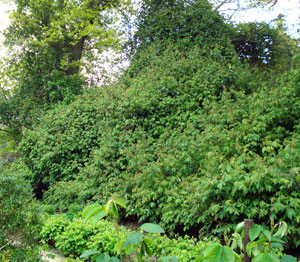
I felt cheated that all those hundreds of blossoms were sitting there in their nascent form getting ready to stun the lucky late May visitors with their multitude. Then and there I vowed I would come back to see it in bloom. The rose bush has been estimated at 66 feet high and 82 feet long. The present owner of the garden, Anne Chambers, warns anyone planning to plant this rose, “It can lift the roof off your house or bar you from entering your garage.” Its ability to overrun a garden should not be underestimated!
I then found my way to the Garden Shop and was pleased to be able to buy a complete list of all the plants at Kiftsgate Court. So many of the houses, National Trust or not, have Tea Rooms, Garden Shops and Plant Sales that are a delight. I must admit it was torture not being able to buy plants and take them home. My driver succumbed to the impulse but had the Chinese lantern plant he’d just decided to buy swept away from in front of him. The UK garden world is highly competitive!!
Kiftsgate Court is open from April through September with varying hours. The website should be consulted before going to visit. www.kiftsgate.co.uk
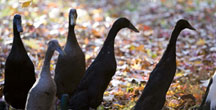
Reveries from Running Duck Farm
By Nan Zander
May be invasive. There are times I have heeded, and times I have ignored that gentle warning. I think that I actually paid money for some ajuga once before I knew better. Not too long ago I bought a single Lysimachia clethroides. It took maybe two seasons for it to go from a breathtaking clump to an evil mass seeking total domination. I read the warning, and bought it anyway. Every spring nurseries and catalogues are full of perennials that may be invasive, but nevertheless, continue to get purchased and planted by enthusiastic gardeners. It requires so much space, and so much time to keep in check such aggressors like phlox and physostegia, lamium and liatris, mint and monarda. However, as intrusive and ill-mannered as they are, they are nothing compared to certain…roses.
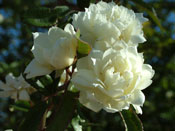
The world’s largest rose bush is a white Lady Banksia that covers over 8,000 square feet in Tombstone Arizona. It is 124 years old. Covered with millions of tiny white blossoms once each spring, it attracts from forty to fifty thousand visitors every year.
In 1885 a young Scottish bride came to live in Tombstone at the local mining company boarding house, which is now the Rose Tree Museum. When the bride’s home was finished, she received a box of shrubs from her family in Scotland. One of these was a rooted cutting of a Lady Banksia that she gave as a gift to the owner of the boarding house. It was planted on the patio, and has been growing virtually care free ever since.
The white Lady Banksia is a species of rose originally brought to England from China in 1803. Being a species, it is strong, simple and fragrant, as it would be growing wild. It has single flowers and a single bloom time, and a hardiness that makes it thrive with little or no effort. Species roses are disease resistant and extremely long lived, and can be propagated from cuttings or seeds. The Tombstone Lady Banksia doesn’t get pruned or fertilized and is watered only a few times a year during prolonged dry spells. Since the one thing I notice my roses need more than anything else is water, I found this hard to believe. Not watered? Arizona? The owner of the Rose Museum believes that the tap root from the plant probably reaches far below the original patio into an abandoned mine that has been full of water for years. Roses are generally susceptible to mildew, so the desert climate eliminates this possible scourge. Most garden roses are heavy feeders but the owner of the Rose Museum, Mrs. Devere assured me that the Tombstone rose is never fertilized. She did remind me, however, that in the 1800’s when the plant was young, there was no real sewer system in Tombstone…

Photos courtesy Tombstone Times
One thing that the World’s Largest Rose Bush needs is support. Its trunk has a fifteeen foot circumference, and the bush is supported by a system of over 200 wooden posts connecting to a lateral trellis of metal pipes. As it grows, more support is added. However, should the Tombstone Rose stop growing some day, there may be an offspring somewhere to take its place. The Rose Museum sells roughly 800 rooted cuttings every year during its annual spring Rose Festival. May be invasive…
To contact Tombstone’s Rose Tree Musem, call 520-457-3326.
To learn more about historic Tombstone, Arizona, including the World’s Largest Rose Bush, visit the Tombstone Times website.
Rosettes
Whether it’s a mosaic floor, or a coffered ceiling, a desk, a bench, a bed, a chair, or a jewel, the rosette is a universal motif. Nearly every major civilization over the last 5,000 years has cultivated the rose, and subsequently used it as a muse in ornament.
The rosette is based on the spiral forms found in nature in which a series of curved lines fan out around a central axis. When one set of curves is set upon another fanning out in the opposite direction, the petal pattern we associate with rosettes is formed.
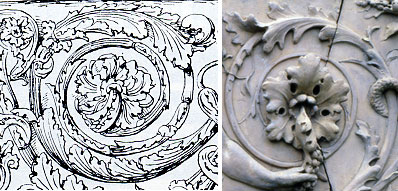
Very naturalistic, leafy rosettes are typical of Greek and Roman ornament (and also of later Renaissance ornament), whereas Assyrian, Ancient Mesopotamian, or Central Asian rosettes are more schematic and stylized.
The Classical oeuvre includes over-the-top rosettes that are naturalistic in one sense — in that you can recognize that the rosette is based in nature; but completely fantastical in another sense — in that you would likely NEVER find that same form in the actual natural world. (See “Roman Ornament” detail from the Villa Aldobrandini in Speltz, The Styles of Ornament, p. 80, pl. 38, fig. 7 and detail from a circa 1900 stoneware frieze.) This hyper-naturalistic rosette returns to that very typical classical concept that, in art, nature should be idealized, or better yet, improved. As a general concept, the renewed interest in botany during the Renaissance must have fueled the use of more luxuriant natural rosettes.

This illustration is, we think, a great testament to the universality of the rosette motif. We are constantly amazed by objects that are incredibly pared down and simple and “proto-modern” (see detail from a mid-20th century composition stone bench) yet, as garden ornament dealers, we are well aware that such “proto-modern” pieces are actually more closely related to ancient forms than anything else (see detail of “Assyrian (Nineveh) and Persian Ornament” from Jones, The Grammar of Ornament, pl. XIII).
What is truly striking is how “modern” the most ancient civilizations were in terms of decorative arts, and how often those forms provided inspiration centuries later. Of course, this full-circle design mantra is especially true in garden ornament, where artists pulled from a vast array of eclectic sources, unconstrained by the need to commit particularly to one movement or another. The public appetite for the fanciful, the classical, or the rustic allowed artisans and manufacturers considerable leeway in their design, giving us the pleasure of indulging whatever style best suits us, or a particular garden space.

Trellises, Arbors, Pergolas
By Katy Keiffer
Man has forever sought to tame nature. Training vines over structures to create verdant “outdoor rooms” and sheltered walkways is just one of the more picturesque methods.
The first trellises date to about 2000 BC. By then their agrarian use was well established. But soon thereafter, garden designers began using them as ornamental devices as well. The Romans, for example, adored roses, and frequently included structures for treillage and walkways (pergolas) in their gardens. Forms are distinct — an arbor, or bower, is meant as a resting place for contemplation and tranquility; trellises can be free-standing structures or attached to walls, making it the most flexible of the forms, while the pergola indicates a covered walk. Two fine examples of pergolas can be seen at Vicarage Garden, East Ruston, Norfolk.

As early examples of pergolas, arbors and trellises were made of wood, few remain. However in the 18th and 19th centuries, cast- and wrought-iron examples became popular. Sometimes these structures were so elaborate they were kept bare of vegetation. A spectacular example of this practice is a wrought-iron arbor known as the Birdcage, at Melbourne Hall in Derbyshire. Sir Thomas Coke, owner of Melbourne Hall, commissioned the Birdcage from master ironmonger Robert Bakewell (1682-1752), whose work can be seen at Derby Cathedral and other notable sites in the area.
A more modern fascination with trellises, and the creation of intimate outdoor spaces can be seen in the work of British architect and garden designer Harold Peto (1854-1933). Peto and his best friend and fellow designer, H. Avray Tipping were enthusiastic proponents of both the formal designs of Italian gardens and the more naturalistic designs favored by the Arts and Crafts Movement. Trellises were popular features in both idioms. Peto and Tipping each created some of the most popular gardens in Britain in the early 20th century, making extensive use of pergola and treillage adorned with different climbing plants such as roses, wisteria, hops and others. The Rose Pergola at Mounton House in Chepstow, Wales designed by Tipping is a particularly striking example of this use.
In the United States, the Bay Area architect and designer, Bernard Ralph Maybeck (1862-1957), echoed the work of Peto and Tipping. Maybeck, best known for his Palace of the Fine Arts in San Francisco, shared their love of the Italianate garden and strove to create a “Mediterranean” design in his work in California. Maybeck’s passion for Mediterranean style expressed itself by the extensive use of trellises, pergolas and arbors. His designs regularly made use of trellises as a distinguishing element of the design. In many of his Bay Area projects, trellises had a four-fold purpose — providing a transition between the architectural design  and the landscape in which it is situated; contributing to a Mediterranean pictorial fantasy, echoing Italian vineyards; creating a mood of romanticized decay with vegetation appearing to completely overrun the structure; and, lastly, using the play of light upon shifting leaves and vines to affect the light within the structure as well as the look of the exterior.
and the landscape in which it is situated; contributing to a Mediterranean pictorial fantasy, echoing Italian vineyards; creating a mood of romanticized decay with vegetation appearing to completely overrun the structure; and, lastly, using the play of light upon shifting leaves and vines to affect the light within the structure as well as the look of the exterior.
The use of trellises and the “Mediterranean” style was widely copied and admired. In fact, I grew up in a residence in far away Rhode Island that was clearly influenced by this aesthetic. Built in 1917, our house, described on the plans as a “villa”, has a grape arbor. And in the original drawings, a pergola was to have been mounted on our circular brick terrace. One day we plan to add the pergola to complete the vision of the architect and our dream of owning a Mediterranean villa.

Strawbery Banke, Portsmouth, New Hampshire
By Katy Keiffer
In the course of doing research on trellises, pergolas and arbors for this issue, I found that Portsmouth, New Hampshire is a treasure trove of historical gardens.
Portsmouth was a prospering harbor and trade center when this country was in its infancy. The city thrived until the war of 1812, when the sea trade and timber industry that built the area collapsed, resulting in a serious economic depression. After the Civil War Portsmouth revived with textiles becoming their key industry. It was during this era that many of the prettiest houses were built, along with magnificent gardens, many of which met my requirements for beautiful trellises and pergolas.
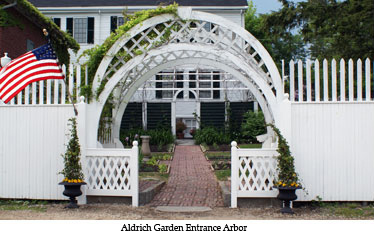
Perhaps the most exceptional Portsmouth site is Strawbery Banke. This waterfront neighborhood dates from the very earliest settlers in 1642 and spans the next 150 years. The area includes houses, taverns and workshops along with historically accurate gardens. James Forti, Curator of Historic Landscape at Strawbery Banke was kind enough to send several photographs from the various properties included in the settlement. He made the point that “Just as plant selection set a tone for appropriate restoration work, the treillage, arbors and pergolas also create a sense of place and time that helps bring history to life.
Some of the highlights include the Aldrich Garden, established 100 years ago with its charming entry arbor and summer house, as well as hops and grape arbors; the Summer House from the circa 1870 Goodwin Garden, another beautiful example of Victorian fantasy in garden planning; and the 18th century Walsh Arbor, the oldest arbor structure in Strawbery Banke.
Strawbery Banke can be further explored at their website, www.strawberybanke.org. The gardens are open from May 1st to October 31st.
———————–
Our next newsletter will focus on Animal Ornaments in the Garden. It will include the garden at Rousham, Oxfordshire, England and Belmont in Nashville as well as a mini-study of cast-iron dog statues and their current popularity.